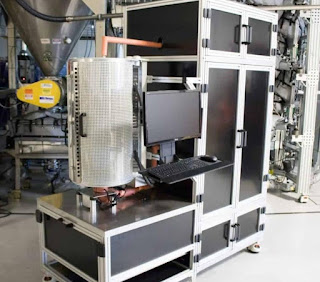Strem´s TDMAT ALD precursor as an attractive alternative to TiCl4
Atomic layer deposition (ALD) of titanium-based compounds has been a crucial process step in the modern semiconductor industry. Titanium nitride (TiN), due to its high electrical conductivity, has been in use as an inorganic anti-reflective coating for lithography, hard-mask for low-κ patterning, transistor gate electrodes, and diffusion barrier for tungsten contacts and Cu interconnects. Intel, in its 10nm, 3rd generation FinFET based technology node, employs a conformal Ti layer to wrap around source/drain diffusion regions to lower the spreading resistance (Link). Apple’s A11 bionic processor chip based on TSMC’s 10nm technology and Samsung’s Exynos 8895 processor chip based on its 10nm technology also incorporates Ti-based liners for tungsten contacts (Link). Globalfoundries and IBM Research investigated cobalt as a replacement of tungsten in the contacts for advanced semiconductor chips, and this process also incorporated a TiN barrier and a Ti liner (Link). TiN electrodes have also been promising for ferroelectric memory applications.
Figure 1: Cross-section, perpendicular to the fin direction, TEM images on the 6T-SRAM area for (a) A11 and (b) Exynos8895. Images (c) and (d) are corresponding EDS mappings of (a) and (b), respectively. (Picture credit: MSSCORPS CO., LTD.)
Titanium dioxide (TiO2) is also an attractive candidate for several thin-film applications, such as high-k material for electronic devices, anti-reflection optical coatings, biocompatible coatings, photocatalysis, and solar cells. Besides, TiO2 is also a constituent of several crucial multi-metal oxide systems, such as strontium titanates (STOs), barium strontium titanates (BSTs), and lead zirconium titanates (PZTs), for dielectric and ferroelectric applications.
The TiCl4 precursor has been widely used to deposit Ti-based thin-films. However, due to severe Cl contamination, low growth per cycle, the corrosive nature of the reaction by-product (mainly HCl), high process temperature, and lower reactivity of TiCl4, the industry switch over to metal-organic precursors is swiftly gaining traction.
Strem Chemicals, Inc., a leading fine chemicals supplier, headquartered in Newburyport, Massachusetts, USA, boasts a vast variety of metal-organic precursors for depositing superior Ti-based thin-films in semiconductor as well as non-semiconductor applications. TDMAT [tetrakis(dimethylamino)titanium(IV)] (Product Catalog Number: 93-2240, CAS Number: 3275-24-9) is one of the most preferred high-purity metal-organic precursors in Strem’s chemical offering. Highly volatile and reactive TDMAT offers adequate vapor pressure even at room temperature and enables low temperature (< 140°C) deposition of high-quality Ti-based thin-films.
Figure 2: TDMAT molecule
Since 1964, Strem Chemicals, Inc. has been serving its clients from academic, industrial and government research and development laboratories as well as commercial scale businesses in the pharmaceutical, microelectronic and chemical/petrochemical industries. Strem also provides custom synthesis (including high-pressure synthesis) and current good manufacturing practice (cGMP) services. With ISO 9001 certification for Quality Management System (QMS) standard and documentation, most of Strem’s products are of reliable high purity, typically 99%, with some at 99.9999% metals purity. Strem utilizes a comprehensive range of analytical techniques tailored to each product to ensure quality because the researchers typically rely on the supplier's quality procedures and documentation, which may be detrimental to a great research idea if poorly conducted. All of Strem's catalogs, since inception, have listed “Color and Form” for every product as primary indicators of quality.
More than fifty years of experience in manufacturing inorganic and organometallic chemicals has enabled Stem to expand its product offering of MOCVD, CVD, and ALD precursors. They are continually adding new products for this dynamic and exciting field. Strem’s product range includes:
Metal alkyls
Metal alkylamides
Metal amidinates
Metal alkoxides
Metal β-diketonates
Metal cyclopentadienyls
Metal halides
Volatile organometallics
Volatile metal carbonyls
Electronic grade chemicals
Single source precursors for mixed metal oxides
Metal alkylamides
Metal amidinates
Metal alkoxides
Metal β-diketonates
Metal cyclopentadienyls
Metal halides
Volatile organometallics
Volatile metal carbonyls
Electronic grade chemicals
Single source precursors for mixed metal oxides
Product mentioned in this blog:
93-2240: Tetrakis(dimethylamino)titanium(IV), 99% TDMAT (3275-24-9)
Related Product Lines & Resources:
CVD & ALD Precursors
MOCVD, CVD & ALD Precursors Booklet
See full Material Science product line
---
Promotional Blog for Strem Chemicals, Inc.
Researched, produced & written by BALD Engineering AB, Stockholm, 2020-01-25
Abhishekkumar Thakur, Jonas Sundqvist
www.baldengineering.com
CVD & ALD Precursors
MOCVD, CVD & ALD Precursors Booklet
See full Material Science product line
---
Promotional Blog for Strem Chemicals, Inc.
Researched, produced & written by BALD Engineering AB, Stockholm, 2020-01-25
Abhishekkumar Thakur, Jonas Sundqvist
www.baldengineering.com



%20(1).png)








